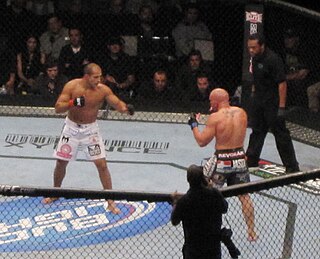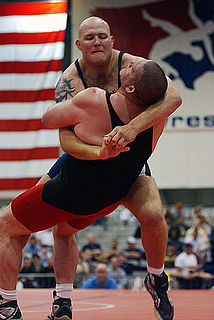
In hand-to-hand combat, grappling is a close fighting technique used to gain a physical advantage such as improving relative position, or causing injury to the opponent. Grappling covers techniques used in many disciplines, styles and martial arts that are practiced both as combat sports and for self-defense.
Professional wrestling holds include a number of set moves and pins used by performers to immobilize their opponents or lead to a submission. This article covers the various pins, stretches and transition holds used in the ring. Some wrestlers use these holds as their finishing maneuvers, often nicknaming them to reflect their character or persona. Moves are listed under general categories whenever possible.
A suplex is an offensive move used in both professional and amateur wrestling. It is a throw that involves lifting the opponent and bridging or rolling to slam the opponent on their back.

In martial arts and combat sports, a takedown is a technique that involves off-balancing an opponent and bringing him or her to the ground with the attacker landing on top. The process of quickly advancing on an opponent and attempting a takedown is known as shooting for a takedown, or simply shooting. Takedowns are usually distinguished from throws by amplitude and impact, with throws being a subset of takedown. Takedowns are featured in all forms of wrestling and stand-up grappling.

A grapple is a hook or claw used to catch or hold something. A ship's anchor is a type of grapple, especially the "grapnel" anchor.
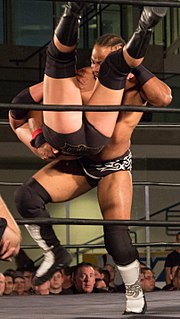
A backbreaker refers to professional wrestling moves which see a wrestler dropping an opponent so that the opponent's back impacts or is bent backwards against a part of the wrestler's body, usually the knee. The standard version of the move sees the wrestler scoop their opponent horizontally before dropping to one knee, slamming the opponent's back on their other knee.

An armlock in grappling is a single or double joint lock that hyperextends, hyperflexes or hyperrotates the elbow joint or shoulder joint. An armlock that hyperflexes or hyperrotates the shoulder joint is referred to as a shoulder lock, and an armlock that hyperextends the elbow joint is called an armbar. Depending on the joint flexibility of a person, armlocks that hyperrotate the shoulder joint can also hyperrotate the elbow joint, and vice versa.

A brainbuster is a professional wrestling throw in which a wrestler puts the opponent in a front facelock, hooks their pants or thigh, and lifts them up as if they were executing a vertical suplex. The wrestler then falls onto their back so that the opponent lands on their head while remaining vertical. This move is a version of the DDT. It was innovated by Killer Karl Kox. Japanese puroresu, the term "brainbuster" refers to a regular vertical suplex, while the move elsewhere known as a brainbuster is referred to as a "vertical drop brainbuster". The brainbuster is banned in WWE because the person receiving the move will land on the top of their head or neck without protection.
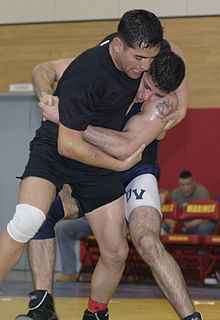
Clinch fighting is the part of stand-up fighting where the combatants are grappling in a clinch, typically using clinch holds. Clinching the opponent can be used to eliminate the opponent's effective usage of some kicks, punches, and melee weapons. The clinch can also be used as a medium to switch from stand-up fighting to ground fighting by using takedowns, throws or sweeps.

A nelson hold is a grappling hold which is executed from behind the opponent, generally when both are on the mat face down with the opponent under the aggressor. One or both arms are used to encircle the opponent's arm under the armpit, and secured at the opponent's neck. Several different nelson holds exist, and they can be separated according to the positioning of the encircling arm(s). A nelson is used to control an opponent or to turn him over on his back and execute a pin.

A grappling hold commonly referred to simply as a hold and in Japanese referred to as katame-waza is a specific grappling, wrestling, judo or other martial arts grip that is applied to an opponent. Holds are principally used to control the opponent, and to advance in points or positioning. Holds may be categorized by their function such as clinching, pinning or submission, while others can be classified by their anatomical effect: chokehold, joint-lock or compression lock.

A grappling position refers to the positioning and holds of combatants engaged in grappling. Combatants are said to be in a neutral position if neither is in a more favourable position. If one party has a clear advantage such as in the mount they are said to be in a "dominant position". Conversely, the other party is considered to be in an inferior position, in that case sometimes called the "under mount".

Kesa-Gatame (袈裟固) is one of the seven mat holds, Osaekomi-waza, of Kodokan Judo. In grappling terms, it is categorized as a side control hold.
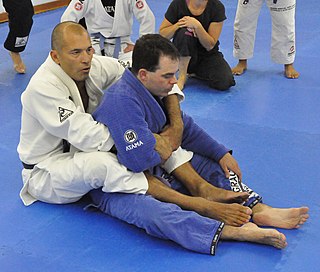
Hooks is a term in grappling martial arts that generally refers to the use of careful positioning of a practitioner’s feet and legs to control and manipulate the movement or position of their opponent. One of the most common uses of hooks is in the back mount position to prevent escape. However, a practitioner may alternatively use hooks to defend, sweep, or attack their opponent.



